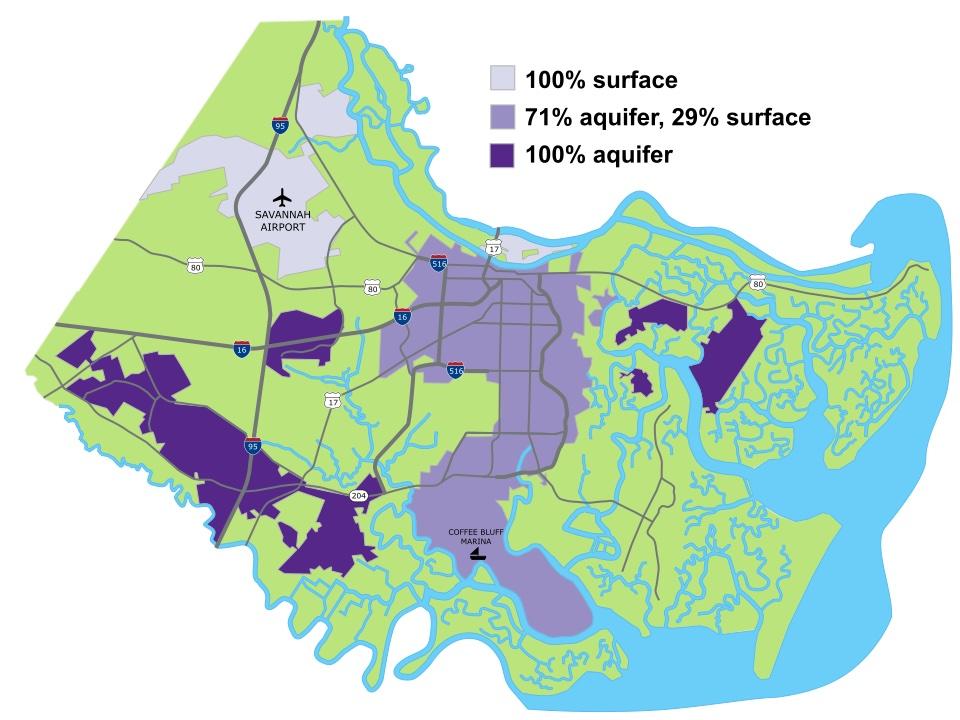
Caption
The map shows the source of water delivered by the city of Savannah in Chatham County. Adapted from Savannah Water Resources.
Credit: Maggie Lee / The Current

The map shows the source of water delivered by the city of Savannah in Chatham County. Adapted from Savannah Water Resources.
Mary Landers, The Current
The 4 million gallons of water a day the Hyundai Motor Group Metaplant America requested is enough to support more than 13,000 homes. That’s almost all the estimated 15,000 households in Bryan County. It’s a lot of water.
But it’s less than a fifth of what paper-making giant International Paper uses from the Floridan aquifer.
IP uses about 39 million gallons of water a day at its two Chatham County sites, with about 21.5 million gallons a day coming from the Floridan aquifer. The company has its own withdrawal permit for 13.5 million gallons per day from the Floridan aquifer and also buys about 26 million gallons of water a day from the City of Savannah. The water it buys is a mix of about 8 million gallons a day aquifer water and the remainder surface water.
The City of Savannah, which pulls 19.9 million gallons a day from the aquifer and 50 million gallons a day from the Savannah River, processes the water and sells it to its own residents, other municipalities, and local industries.
International Paper is Savannah’s top industrial ratepayer by volume.
The U.S. Sugar Savannah Refinery is Savannah’s next biggest industrial water user at 1.8 million gallons per day. BASF is third at 1.24 million gallons per day. These manufacturers also receive about 30% surface water and 70% ground water from the City of Savannah.
Like these companies, other industrial users in Coastal Georgia also buy their water from municipalities, so well permits don’t tell the whole story of water use by local manufacturers. But comparing well permits does give context to Hyundai’s request. The 6.625 million gallons a day expected from the four wells for Hyundai and associated development ranks as the 8th largest industrial-related pull from the Floridan aquifer statewide. It would qualify as the 14th largest pull of any type from the Floridan in Georgia.
The 4 million gallons a day destined for the Metaplant itself puts it in the same 8th place rank for industrial use of the Floridan aquifer in Georgia.
That volume puts it 25th overall. The two biggest Floridan aquifer users are Rayonier Advanced Material, or RYAM, in Jesup, and Brunswick Cellulose, with permits of 68 mgd and 45 mgd respectively that dwarf all other users from this source.
Ken Copi, a retired metallurgical engineer who lives near the Hyundai facility in Ellabell, noted that the paper industry and auto industry share a thirst for cheap, clean water.
“For high quality paper you need very pure water,” he wrote in an email to The Current. “Mills in other parts of the county needed purification plants to meet these standards. Expensive to install and operate. When they found out Georgia/Florida aquifer water already met these requirements they started moving to the Southeast to save boatloads of money. Now it appears automakers may be doing the same.”
There’s a growing call to wean industrial users off this groundwater they’ve used for decades and prioritize the Floridan aquifer for drinking and growing food.
“This region is growing,” said Ben Kirsch, legal director of the Ogeechee Riverkeeper. “There’s more people coming in, and those people are going to need water, and it’s a prioritization of how the aquifer is used. The aquifer needs very little treating. It’s pristine water, and we really think that it should be used for human uses, whether that’s for domestic supply or for agriculture.”
“We want to sustain the aquifer. We want to see it start to recover, and as you draw millions of gallons a day out of it. You’re not necessarily helping it. That’s not helping it recover.”
This story comes to GPB through a reporting partnership with The Current.
